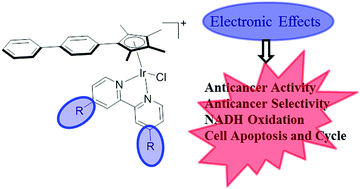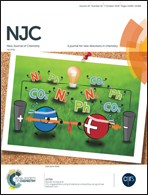Electronic effects on reactivity and anticancer activity by half-sandwich N,N-chelated iridium(iii) complexes†
Abstract
The synthesis and characterization of a series of organometallic half-sandwich N,N-chelated iridium(III) complexes bearing a range of electron-donating and withdrawing substituents were described. The X-ray crystal structures of complexes 1, 3 and 5 have been determined. This work demonstrated how the aqueous chemistry, catalytic activity in converting coenzyme NADH to NAD+ and anticancer activity can be controlled and fine-tuned by the modification of the ligand electronic perturbations. In general, the introduction of an electron-withdrawing group (–Cl and –NO2) on the bipyridine ring resulted in increased anticancer activity, whereas an electron-donating group (–NH2, –OH and –OCH3) decreased the anticancer activity. Complex 6 bearing a strongly electron-withdrawing NO2 group displayed the highest anticancer activity (7.3 ± 1.2 μM), ca. three times as active as cisplatin in the A549 cell line. Notably, selective cytotoxicity for cancer cells over normal cells was observed for complexes 1 and 6. DNA binding does not seem to be the primary mechanism for cancer fighting. However, the aqueous chemistry, cell apoptosis and cell cycle, which show similar dependence on the ligand electronic perturbations as the anticancer activity, appear to together contribute to the anticancer potency of theses complexes. This work may provide an alternative strategy to enhance anticancer activity for these N,N-chelated organometallic half-sandwich iridium(III) complexes.



 Please wait while we load your content...
Please wait while we load your content...